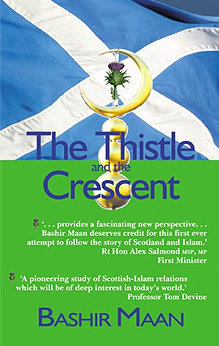
Author: Bashir Maan
Genre: Islam
Publisher: Argyll Publishing; 2nd edition
Release Date: 2 February 2009
Format: Paperback
Pages: 256
Source: No longer available on the website
Bashir Maan builds on his earlier work ‘The New Scots, The Story of Asians in Scotland’ published in 1992. Here his sweep is far more comprehensive and well-researched. The book is “divided into six chapters and begins with a Prologue that briefly examines the advent of Christianity in Scotland with the rise of Islam and its spread in the Levant. The first chapter, Early Contacts between Islam and Scotland, deals with contacts through pilgrims and traders. Scotland had trading links with Egypt, North Africa and the Iberian Peninsula even before medieval times and before the arrival of Islam to those countries. According to the well-known legend of Scota, the very origin of the Scots is linked to Egypt….Chapter 2, The Crusades and Scotland, discusses the impact and influence of Islam on Scotland during the Crusades, spread over four centuries…Chapter 3, Diplomats, Scholars and Travellers, explores connections developed during the Middle Ages, between Scotland and Islam…William Lanark was a seventeenth century adventurer who was one of the Scottish travellers who ventured to the Islamic lands….Chapter 4, The British Empire, seeks to investigate the relationship between Islam and Scotland from the eighteenth to the twentieth century….Chapter 5, Islam in Scotland, relates a brief history of the settlement of the Muslim community in Scotland. It explores reasons why they came to Scotland, where they originated from, their early experiences in Scotland, their progress and their growth up to the beginning of the twenty first century…Chapter 6, What is Islam? briefly explains the essence of Islam…”
In pinning a date for Scotland’s first contact with the Muslim world, Bashir Maan settles for “the discovery in 1912 of silver coins from a hoard at Talnotrie, Glen of the Bar, Kirkcudbrightshire, bearing the name of the Abbasid Caliph al-Mutawakkal Ala Allah (r. 847-862)”. By the twelfth century, Scot merchants who came to trade in Alexandria had established their own hostel in the city. Among the remarkable vignettes gathered by the author is the one on King Edgar of Scotland, who after the First Crusade brought back with him a camel! The memories of the Crusades remains today in well-preserved talismans such as a red charm stone that was brought back, and which “had properties to cure sick cattle when they drank the water in which it had been dipped”, or the legend about “the fairy banner of Dunvegan”. Slightly mischievously, the author also notes the ease with which the Scots could be diverted from the Crusades to their “local ‘crusade’ against the English”. At other points too, Mr Maan is unable to suppress his eye of the unexpected, and relishes in a rather risqué account of the encounter of one Usama Ibn Munqudh with a Frankish knight and his wife in the public baths of a Muslim city.
Bashir Maan also suggests that the first Scots Arabist was Michael Scot , born in 1175 at Balweirie Castle, who helped King Fredrick of Sicily negotiate peace terms with the Muslim ruler of Syria and Egypt in the early thirteenth century. “Better known as ‘The Wizard’…he left for Spain to seek Arabic learning. He settled in Toledo…and began translating Arabic works into Latin…Scot died in 1232…according to some accounts in Scotland. He is buried in Melrose Abbey….his statue on his tomb….is shown wearing Muslim dress with a trimmed beard and Arab head-dress”. The author recounts his adventure in tracing the statue.
King Jamies III (r.1460-88) “appears to be the first Scottish ruler who sent a diplomat [Anselm Adornes] to introduce Scotland and its ruler to a part of the Muslim world [North Africa and Egypt] with which it had trade and cultural links for centuries”. During the fifteenth century, “some high diplomats and learned members of the nobility found Islam attractive and joined its ranks with conviction. A general in the Ottoman armed forces known as Inglis Mustafa was actually a Campbell from Scotland.” Another Scottish girl, Helen Gloag from Perthshire, married the Sultan of Morocco in the eighteenth century.
The first institutional developments undertaken by Scottish Muslims in the twentieth century include the establishment of a branch of the London-based Jamiat ul Muslimeen in Glasgow in 1933. The community mainly originated from “a small area around both banks of the River Sutluj in India” – from the banks of the Sutluj to the banks of the Clyde. The first mosque was established in 1944.
‘The Thistle and the Crescent’ is rich in detail and is testimony to the wide reading and original research that underpins the author’s labour of love. Moreover it is not only a historical account, but addresses common misconceptions about Islam and Muslim practices. The author himself is part of the history of the twentieth century Muslim settlement in Scotland – he emigrated from Pakistan in 1953 and was the fist Muslim councillor in Britain when he was originally elected to Glasgow City Corporation in 1970. In April 2003 he stepped down as councillor of Ferthill Ward, Glasgow, at the age of 75. He was also the Deputy Lieutenant of Glasgow.
